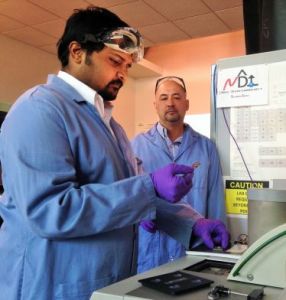Mar 12 2014
Researchers have discovered that creating a graphene-copper-graphene “sandwich” strongly enhances the heat conducting properties of copper, a discovery that could further help in the downscaling of electronics.
 Pradyumna Goli, left, and Alexander Balandin in Balandin's Nano-Device Laboratory
Pradyumna Goli, left, and Alexander Balandin in Balandin's Nano-Device Laboratory
The work was led by Alexander A. Balandin, a professor of electrical engineering at the Bourns College of Engineering at the University of California, Riverside and Konstantin S. Novoselov, a professor of physics at the University of Manchester in the United Kingdom. Balandin and Novoselov are corresponding authors for the paper just published in the journal Nano Letters. In 2010, Novoselov shared the Nobel Prize in Physics with Andre Geim for their discovery of graphene.
In the experiments, the researchers found that adding a layer of graphene, a one-atom thick material with highly desirable electrical, thermal and mechanical properties, on each side of a copper film increased heat conducting properties up to 24 percent.
“This enhancement of copper’s ability to conduct heat could become important in the development of hybrid copper – graphene interconnects for electronic chips that continue to get smaller and smaller,” said Balandin, who in 2013 was awarded the MRS Medal from the Materials Research Society for discovery of unusual heat conduction properties of graphene.
Whether the heat conducting properties of copper would improve by layering it with graphene is an important question because copper is the material used for semiconductor interconnects in modern computer chips. Copper replaced aluminum because of its better electrical conductivity.
Downscaling the size of transistors and interconnects and increasing the number of transistors on computer chips has put an enormous strain on copper’s interconnect performance, to the point where there is little room for further improvement. For that reason there is a strong motivation to develop hybrid interconnect structures that can better conduct electrical current and heat.
In the experiments conducted by Balandin and the other researchers, they were surprised that the improvement of thermal properties of graphene coated copper films was significant despite the fact that graphene’s thickness is only one atom. The puzzle was solved after they realized the improvement is the result of changes in copper’s nano- and microstructure, not from graphene’s action as an additional heat conducting channel.
After examining the grain sizes in copper before and after adding graphene, the researcher found that chemical vapor deposition of graphene conducted at high temperature stimulates grain size growth in copper films. The larger grain sizes in copper coated with graphene results in better heat conduction.
Additionally, the researchers found that the heat conduction improvement by adding graphene was more pronounced in thinner copper films. This is significant because the enhancement should further improve as future copper interconnects scale down to the nanometers-range, which is 1/1000thof the micrometer range.
In the future, Balandin and the team would like to investigate how heat conduction properties change in nanometer-thick copper films coated with graphene. They also plan to develop a more accurate theoretical model to explain how thermal conductivity scales with the grain sizes.
In addition to Balandin and Novoselov, co-authors of the Nano Letters paper, “Thermal Properties of Graphene-Copper-Graphene Heterogeneous Films,” were: Pradyumna Goli, a post-doctoral student in Balandin’s lab and Hao Ning, Xuesong Li and Ching Yu Lu, all of whom work for Bluestone Global Tech in Wappingers Falls, NY.
The work at UC Riverside on this project was supported by the National Science Foundation and by STARnet Center for Function Accelerated nanoMaterial Engineering (FAME), a Semiconductor Research Corporation (SRC) program sponsored by Microelectronics Advanced Research Corporation (MARCO) and Defense Advanced Research Projects Agency (DARPA)